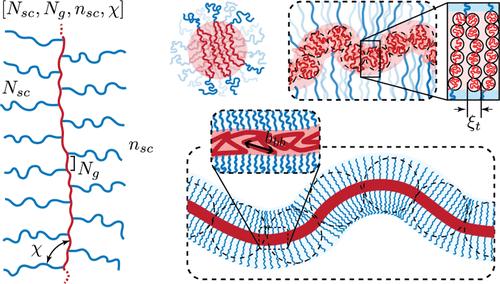熔体中可折叠瓶刷聚合物的分子结构
IF 5.2
1区 化学
Q1 POLYMER SCIENCE
引用次数: 0
摘要
瓶刷聚合物由长线性主链和许多相对较短的侧链密集接枝而成。一个被广泛接受的观点是,高度重叠的侧链之间的强空间排斥力使瓶刷骨架预应变,导致聚合物的低延展性。然而,我们最近发现,在侧链和主链高度不相容的瓶刷聚合物熔体中,无论侧链之间有很强的空间排斥力,主链都会坍塌以降低界面自由能。尽管有了这一发现,这些所谓的“可折叠”瓶刷聚合物的分子结构及其组件仍然知之甚少。在这里,我们提出了可折叠瓶刷聚合物的分子结构、介观构象和宏观性质之间的确定性关系。实验结果表明,随着侧链接枝密度的减小,瓶刷直径增大,瓶刷端到端距离减小。这些行为与现有的瓶刷聚合物的理解相矛盾,后者假设主链和侧链是相容的。由于可折叠瓶刷聚合物存储的长度可以在大变形时释放,因此它们提供了一种方法来解耦单网络弹性体中固有的刚度和可扩展性权衡。这些发现为使用可折叠瓶刷聚合物作为设计软(生物)材料的构建块提供了基础见解。本文章由计算机程序翻译,如有差异,请以英文原文为准。

Molecular Structure of Foldable Bottlebrush Polymers in Melts
A bottlebrush polymer consists of a long linear backbone densely grafted with many relatively short side chains. A widely accepted view is that strong steric repulsion among the highly overlapped side chains prestrains the bottlebrush backbone, resulting in low polymer extensibility. However, we recently discovered that in the melt of bottlebrush polymers with highly incompatible side chains and backbone, the backbone collapses to reduce interfacial free energy, regardless of the strong steric repulsion among side chains. Despite this discovery, the molecular structure of these so-called “foldable” bottlebrush polymers and their assemblies remains poorly understood. Here, we present the deterministic relationships among molecular architecture, mesoscopic conformation, and macroscopic properties of foldable bottlebrush polymers. A combination of scaling theory and experiments reveals that as the side chain grafting density decreases, the bottlebrush diameter increases, whereas the bottlebrush end-to-end distance decreases. These behaviors contradict the existing understanding of bottlebrush polymers, which assumes that the backbone and side chains are compatible. Since foldable bottlebrush polymers store lengths that can be released upon large deformations, they offer a way to decouple the intrinsic stiffness-extensibility trade-off in single-network elastomers. These findings provide foundational insights into using foldable bottlebrush polymers as building blocks for designing soft (bio)materials.
求助全文
通过发布文献求助,成功后即可免费获取论文全文。
去求助
来源期刊

Macromolecules
工程技术-高分子科学
CiteScore
9.30
自引率
16.40%
发文量
942
审稿时长
2 months
期刊介绍:
Macromolecules publishes original, fundamental, and impactful research on all aspects of polymer science. Topics of interest include synthesis (e.g., controlled polymerizations, polymerization catalysis, post polymerization modification, new monomer structures and polymer architectures, and polymerization mechanisms/kinetics analysis); phase behavior, thermodynamics, dynamic, and ordering/disordering phenomena (e.g., self-assembly, gelation, crystallization, solution/melt/solid-state characteristics); structure and properties (e.g., mechanical and rheological properties, surface/interfacial characteristics, electronic and transport properties); new state of the art characterization (e.g., spectroscopy, scattering, microscopy, rheology), simulation (e.g., Monte Carlo, molecular dynamics, multi-scale/coarse-grained modeling), and theoretical methods. Renewable/sustainable polymers, polymer networks, responsive polymers, electro-, magneto- and opto-active macromolecules, inorganic polymers, charge-transporting polymers (ion-containing, semiconducting, and conducting), nanostructured polymers, and polymer composites are also of interest. Typical papers published in Macromolecules showcase important and innovative concepts, experimental methods/observations, and theoretical/computational approaches that demonstrate a fundamental advance in the understanding of polymers.
 求助内容:
求助内容: 应助结果提醒方式:
应助结果提醒方式:


